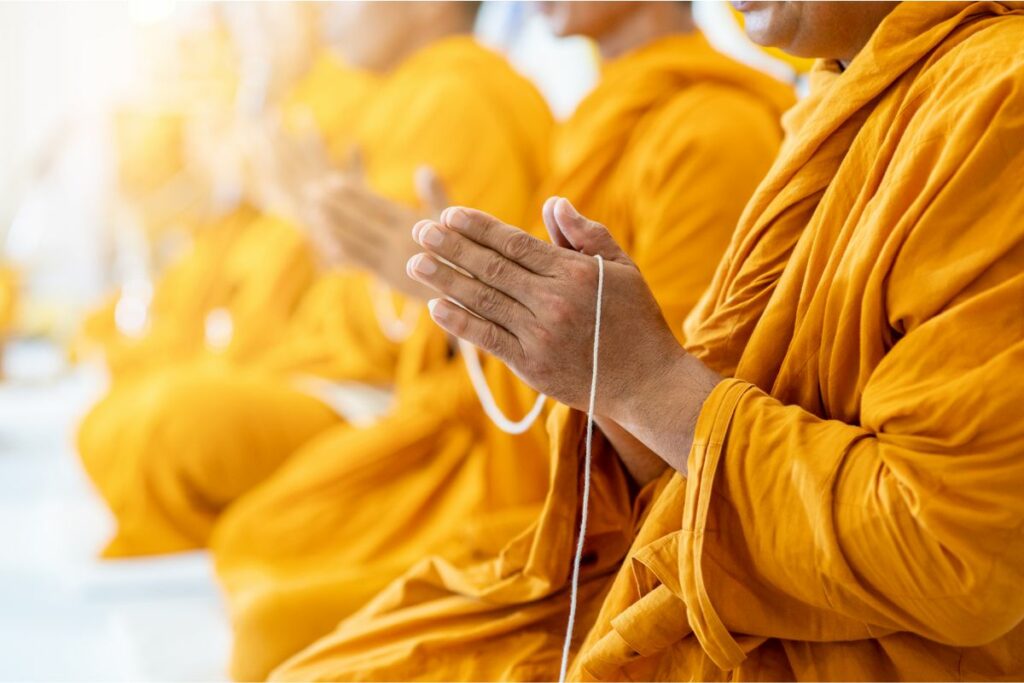In this blog post, we’re going to discuss the Buddhist funeral prayer rites, which can help you during this difficult time. We’ll cover the nature of the physical body, the importance of the current life, and the deceased person in the afterworld. We’ll also discuss the mourning period and the bereaved family, as well as the days after death.
Finally, we’ll provide a guide to Buddhist funeral prayer rites, which will help you express your religious beliefs and mourn the loss of a loved one.
Buddhist Beliefs: The Nature of the Physical Body
When someone dies, it can be a difficult time for everyone involved. Friends and family may feel lost, and they may have questions about what to do next. This guide is designed to help you through the Buddhist funeral prayer rites, which are a ceremony that is used to help mourn the loss of a loved one.
The Buddhist funeral prayer rites are based on the belief that the body is impure and temporary. This means that we should not grieve overly heavily over the death of a loved one – our emotions should be focused on helping them move on in their spiritual journey. The body is not who we are – we are our soul, and our soul will continue to exist after our physical body has died.
The body will eventually decay, and at that point we will no longer be able to experience life in this world. However, even in death we remain connected to those around us – through memories and love. After going through the Buddhist funeral prayer rites, friends and family can finally begin to move on from this difficult time.
What to Expect During Buddhist Funeral Prayers
Buddhist funeral rites can be an emotional and difficult experience for everyone involved. As the person responsible for conducting the ceremony, it is important to know what to expect so that you can support those involved in the process. Below, we will outline the main points of Buddhist funeral rites and what to expect during each stage.
Visitation
The first stage of Buddhist funeral rites is called visitation. During visitation, friends and family of the deceased come to pay their respects and say goodbye. This period can be quite emotional, as people may feel overwhelmed by sadness and grief at this time.
Preparation
The second stage of Buddhist funeral rites is called preparation. During preparation, friends and family of the deceased clean up any belongings that have been left behind and make arrangements for transporting the body to its final resting place. This period also allows friends and family time to grieve in private.
Welcoming
The third stage of Buddhist funeral rites is called welcoming. During welcoming, monks lead prayers in honor of the deceased before carrying out the actual burial ceremony. After welcoming, there may be a period of silence or reflection as people absorb what has happened.
Vigil
The fourth stage of Buddhist funeral rites is called the vigil. The vigil typically lasts for 49 days – this is intended to represent how long it takes for a newly born baby’s soul to reach maturity. During the vigil, people may continue praying or meditating in honor of their loved one until their soul leaves this world on its own accord or until they are reborn into a new life.
It’s important to remember that while Buddhism believes in rebirth, there is no guarantee that someone will be reborn into a happy or meaningful life – every individual’s path is unique.
The Importance of the Current Life
Buddhist funerals are a solemn and important ritual in the Buddhist faith. Based on the teachings of the Buddha, these ceremonies are meant to help those who are grieving and support those who are mourning. There are three key elements to Buddhist funeral rites: the funeral service, the offering of gifts, and the cremation.
The funeral service is typically held at a temple or shrine, and it is based on the principles taught by Buddha. The purpose of this service is to help remember the life of the deceased and to provide support for those who are grieving. The ritual will vary depending on the tradition of Buddhism, but in general it will include readings from scriptures, prayers, and music. Afterward, there will usually be an offering of food or flowers to honor the deceased.
The next step in Buddhist funerals is providing gifts for the deceased’s family members. This can be done through donations to a charity or through presenting them with special items like jewelry or clothing. Often times friends and family members will also make donations to a memorial fund in honor of their loved one.
Finally, Buddhists believe that all beings have a soul and that death is simply another phase in their journey toward enlightenment. Accordingly, cremation is typically considered preferable over burial because it allows ashes to be scattered in a sacred place where they can continue benefiting others long after they have died.
The Rites of a Buddhist Funeral
The Buddhist funeral rites are designed to help the deceased person’s soul move on to the next life. These rites are also known as pujas, and they are carried out in order to create a peaceful and auspicious environment for the soul to depart from the body. The purpose of these ceremonies is twofold: first, it allows the deceased person’s soul to be released from their physical body without any pain or suffering; and second, it helps to create a good foundation for the deceased person’s next life.
About The Procession
The most important part of a Buddhist funeral is the procession. This is when family members, friends, and other mourners gather around the coffin or casket lid and walk with it as it is transported from the house of mourning to the crematorium or burial ground. The procession serves as both a guide for the soul and an assurance that all necessary prayers have been said and performed for the deceased.
The Deceased Person in the Afterlife
When a loved one dies, it is natural to feel grief. Grieving involves feeling sadness, anger, and other emotions that are associated with the loss of a loved one. It can be a difficult process, but it is important to go through it in order to move on. Below, we will outline the steps that you should take in order to help you through your grieving process.
What Happens in the Afterlife According to Buddhist Beliefs
Understand that the deceased person in the after life is still alive and well. They may have gone through some difficult experiences in life, but they are not gone forever. The deceased person still has feelings and needs just as any other human does. You can communicate with them by praying for them or sending them positive thoughts.
Act Respectfully During Mourning
It is important for family and friends of the deceased person to act respectfully towards them during their time of mourning. This means not speaking ill of the deceased or making fun of their death. It also means being there for them when they need you – no matter what that looks like for each individual family member/friend.
The Buddhist Mourning Period – 49 Days after Death
The 49-day period of mourning in Buddhism is a time for friends and family to come together and support one another in their grief. This period is also a time for the deceased to transition into the next phase of their existence.
Buddhism teaches that death is not the end, but rather a natural part of the cycle of life. It is believed that after death, the consciousness of the deceased remains for a time in a state known as the “Bardo” before being reborn in a new body.
During the 49-day period, the deceased is believed to be in the Bardo, and it is the responsibility of their loved ones to help guide them through this transitional phase. This is done through prayers and rituals, as well as acts of kindness and generosity in the deceased’s memory.
The 49-day period is divided into three stages, each with its own set of customs and traditions. The first week is known as the “Sitting Week” and is a time for the immediate family to come together and support one another. The second week, known as the “Standing Week,” is a time for extended family and friends to visit and pay their respects. The third week, known as the “Crying Week,” is a time for the community to come together and hold memorial services.
During these 49 days, it is customary to make offerings to the deceased, such as food, clothing, and other items that they enjoyed in life. These offerings are believed to provide comfort and support to the deceased as they make their journey through the Bardo.
In addition to these specific customs, the 49-day period is a time for reflection and contemplation. It is a time to remember the deceased and to consider the lessons that their life and death have taught us. It is also a time to consider our own mortality and to strive to live our lives in a way that will bring us closer to enlightenment.
How to Pray for the Deceased
There are many different Buddhist funeral prayer rites that people can choose from, depending on their beliefs and preferences. Some of the most common rites involve chanting, burning incense, and offerings to the deceased. Below, we will outline the main steps involved in these rites and how to perform them.
Gather Necessary Prayer Materials
First, gather all of the materials that you’ll need for the rite: candles, incense, flowers, food items (if offering), and anything else that you feel may be helpful. Once you’ve gathered everything necessary, prepare your space by setting up a altar or space where you will be praying.
Light a Joss Stick
Next, light a joss stick and place it at the front of the altar. In Buddhism, the joss sticks are used to represent the Buddha and his teachings. They are often placed near altars during ceremonies.
Recite a Prayer
Lastly, recite a prayer for the deceased person. This prayer can be written or simply spoken aloud. Afterward, offer prayers for their long life after death and for enlightenment on what they should do next in their cycle of rebirths.
Final Words
Death is a natural process that happens to everyone. It is important to be prepared for it and to understand what happens to the physical body and the person’s spirit after they die. The mourning period is also an important time for the bereaved family members to grieve and remember their loved one.


